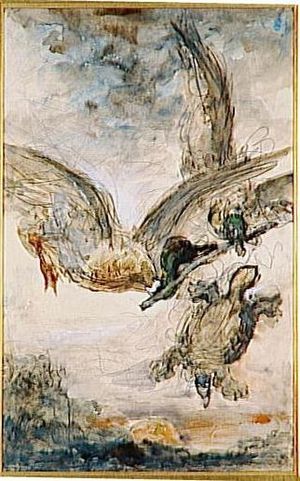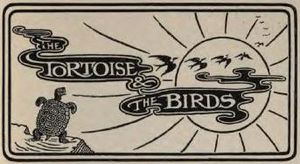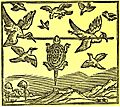The Tortoise and the Birds facts for kids

The Tortoise and the Birds is a famous fable (a story with a moral lesson). It likely started as a folk tale, with early versions found in both India and Greece. There are also similar stories from Africa. The lessons these stories teach can be different, depending on where and how they are told.
Early Indian Stories

One of the oldest versions of this story comes from ancient India. It's found in Buddhist writings called the Kacchapa Jataka. In this tale, a king finds a tortoise that has fallen from the sky and split open. His helper explains that this happened because the tortoise talked too much.
The story goes that a tortoise became friends with two geese. They promised to take it to their home in the Himalayas. The geese held a stick in their beaks, and the tortoise held the middle of the stick in its mouth. They warned the tortoise not to talk. As they flew, children below made fun of the tortoise. When it opened its mouth to answer back, it fell and was destroyed.
These Jataka tales were often shown in art. You can find this story carved into stone on old religious buildings in India and Java. These carvings often show different parts of the story, like the birds carrying the tortoise, its fall, and what happened when it hit the ground. For example, at the 9th-century Mendut temple in Java, you can see the birds and tortoise flying, and then hunters on the ground preparing to eat the fallen tortoise.
Another Indian version of the story is in the Panchatantra. In this tale, a tortoise and its friends live in a lake that is drying up. The geese feel sorry for their friend and suggest the same stick plan. As they fly over a city, people below make comments. The tortoise tells them to mind their own business. Because it spoke, it falls and is eaten. This story was later included in a collection called the tales of Bidpai. It then traveled to many other countries through different translations.
Later, the French storyteller Jean de la Fontaine wrote his own version, La Tortue et les deux Canards (The Tortoise and the Two Ducks). In his story, the tortoise wants to travel. Two ducks offer to fly her to America. But on the way, she hears people below call her "the queen of tortoises" and shouts to agree. This makes her fall. For La Fontaine, the story teaches about being too proud and not thinking carefully.
A similar folk tale from Mongolia features a frog instead of a tortoise. A frog is jealous of geese flying to a warmer place. The geese suggest the stick plan. The frog is so happy that it shouts down to its frog friends, causing it to fall.
Aesop's Fables
There are two stories about a tortoise and birds that are part of Aesop's Fables. One is from ancient Greece, and the other from ancient Rome.
In the Greek version, a tortoise really wants to see more of the world. It convinces an eagle to fly it up high, promising gifts in return. Once they are above the clouds, the eagle drops the tortoise onto a mountaintop. The lesson from this story is that you should be happy with what you have.
The Roman version, called "The Eagle and the Crow," is a bit different. It starts by saying that no one is safe from powerful people, especially if there's also bad advice involved. In this story, an eagle catches a tortoise but can't eat it because of its hard shell. A crow flying by tells the eagle to drop the tortoise from high up onto the rocks below. After the tortoise breaks, the two birds share the meal.
African Stories
A well-known African fable about the tortoise and the birds comes from the Igbo people. It's found in the famous novel Things Fall Apart by Chinua Achebe. In this story, the tortoise is a clever trickster. He hears about a feast that sky-dwellers are having for the birds. He convinces the birds to take him along by giving him some of their feathers to make wings.
At the feast, the tortoise tells the hosts his name is "All-of-you." So, when the hosts say, "This food is for all of you," the tortoise claims the entire feast for himself! The angry birds take back their feathers and leave him. Only the parrot agrees to take a message to the tortoise's wife. The tortoise tells his wife to put soft bedding on the ground for him to jump onto. But the parrot tells her to put out all the hard things instead. When the tortoise jumps down, his shell breaks. He survives, but his shell is glued back together, which is why it looks uneven today.
Similar stories are also told by the Swazi people and the Kikuyu.
Combined Stories
Sometimes, different versions of these tortoise fables are combined. For example, in some African stories, the tortoise gets back to earth safely. But then the birds decide to play a trick on him. They have a feast on the ground and say only those with clean claws can eat. The birds fly to the river to clean their claws and then land on the food. But the tortoise has to crawl, so his feet get dirty on the way back. He misses the feast.
In a story from Sri Lanka, the tortoise survives its fall to earth. But then it is caught by a hungry jackal. The tortoise tricks the jackal into soaking its shell in the river to make it soft. When the jackal lifts its paw, the tortoise swims away to safety.
Some stories combine parts of Aesop's fables. For instance, in a retelling by Joseph Jacobs, an eagle is carrying a tortoise to a new home. A crow reminds the eagle that tortoises are good to eat. So, the eagle drops the tortoise on a sharp rock, and the two birds share the meal. The lesson from this combined story is: "Never soar aloft on an enemy's pinions" (meaning, don't trust your enemies to help you).
Images for kids
-
A wood carving from Thomas North's translation of Bidpai, 1570.



